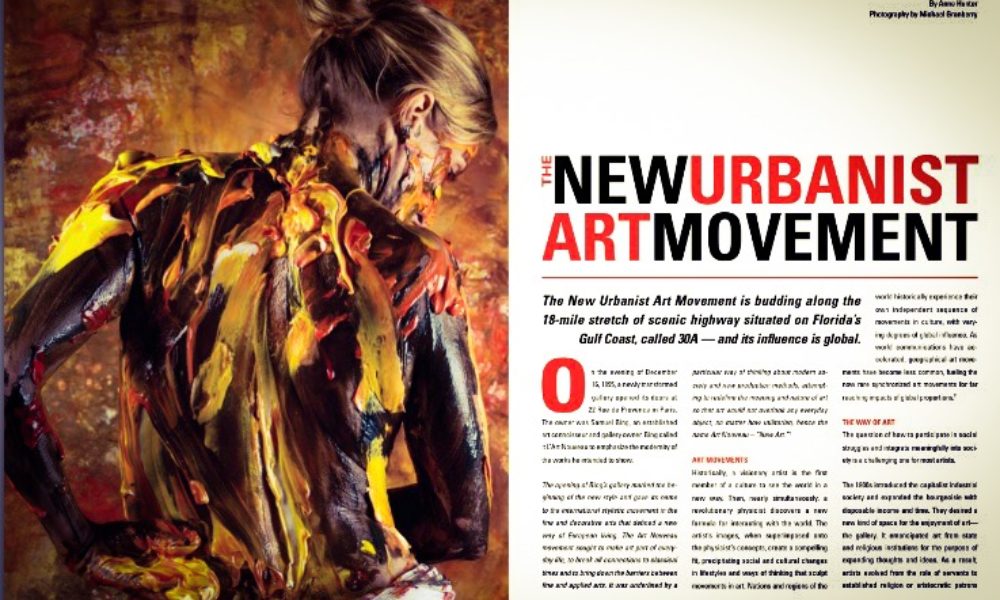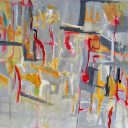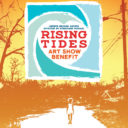The New Urbanist Art Movement is budding along the 18-mile stretch of scenic highway situated on Florida’s Gulf Coast, called 30A — its influence is global.
On the evening of December 16, 1895, a newly transformed gallery opened its doors at 22 rue de Provence in Paris. The owner was Samuel Bing, an established art connoisseur and gallery owner. His renovated gallery was devoted to the work of leading artists. Bing called it, L’Art Nouveau to emphasize the modernity of the works he intended to show. In explanation of his intentions, Bing wrote in 1902:
“L’Art Nouveau, at the time of its creation, did not aspire in any way to the honor of becoming a generic term. It was simply the name of an establishment opened as a meeting ground for all ardent young spirits anxious to show the modernity of their tendencies and open to all lovers of art who desired to see the working of unrevealed forces of our time.”
At that time, one would have had difficulty in recognizing the coherent style which we now call Art Nouveau. The opening of Bing’s gallery marked the beginning of the new style and gave its name to the international stylistic movement in the fine and decorative arts that defined a new way of European living. The Art Nouveau movement sought to make art part of everyday life, thought to break all connections to classical times and bring down the barriers between the fine arts and applied arts. Art Nouveau was underlined by a particular way of thinking about modern society and new production methods, attempting to redefine the meaning and nature of the work of art, so that art would not overlook any everyday object, no matter how utilitarian. Hence the name Art Nouveau – “New Art”. 2
Art Movements
Historically, a visionary artist is the first member of a culture to see the world in a new way. Then, nearly simultaneously, a revolutionary physicist discovers a new formula for interacting with the world. The artists’ images, when superimposed on the physicists’ concepts, create a compelling fit, precipitating the social and cultural changes in lifestyle, religion and ways of thinking that sculpt movements in art. Nations and regions of the world historically experience their own independent sequence of movements in culture with varying global influence. As world communications have accelerated, geographical art movements have become less common, fueling the few synchronized art movements for far reaching impacts of global proportions. 4
The Way of Art
The question of how to participate in social struggles and integrate meaningfully into society is a challenging one for most artists.
The 1800’s introduced the capitalist industrial society and expanded the bourgeoisie class with disposable income and leisure time. They desired a new kind of space for the enjoyment of art – the gallery, a private/public space that emancipated art from state and religious institutions for the purpose of expanding thoughts and ideas into other metaphysical realms, undefined by form and structure. As a result, artists evolved out of the role of servants to established religion or aristocratic patrons and into a world propelled by their individual artistic desires toward the unique field of pure art, where the artists would be judged on their merits by a larger and more populistic society – the marketplace, the critics and the gallery patrons.
The advent of the gallery presented an interesting dilemma for the artist. The pursuit of an engagement with society in the form of the art gallery brought the inevitable reality that in order to integrate or be understood; there must be some degree of exchange, or bridging to and from the distinctively different lifestyle of the artists and their patrons. Conversely, their patrons as business capitalists faced an identical struggle when contemplating life devoted to the appreciation of the arts.
The disparity between the two worlds has created a social gap that is rarely traversed and when attempted, ultimately creates a conflict which causes both the artist and the capitalist to work in ways that break with the dominant paradigms and established institutions of both the metaphysical creative world and static framework of capitalist society. The few pioneers who tread this course are regarded as renegades, as free-thinkers or mavericks in their respective fields.
For the artist, there are moments during which the desire for social or market change has led to working within the sphere of business capital to align themselves with wider social movements or to break with the established institutions of art.
For the capitalist, it serves his social and political purpose to consider how to leverage the arts for his favor, by positing art as outside of the political engagement – and also as dependent upon the perpetuation of existing economic conditions and social relationships. 1
The New Urbanist Real Estate Sector
The New Urbanism is an emerging real estate sector that offers challenges and opportunities related to the traditional resort model. These changes are complex and multi-layered, encompassing everything from design and master planning to construction and development, operations, and the retail mix. Driving this change is a customer demographic dictating far-reaching and fundamental changes related to evolving lifestyles and consumer preferences.
New Urbanites value premium real estate offerings complimented with a revolutionary slate of amenities and experiential components, as a way of expressing their creative spirit in a community-oriented lifestyle. The market research clearly points to a number of trends that continue to dramatically redefine the real estate marketplace; the singularly most significant change is the marked consumer movement towards authentic high quality amenities and activities; experiences that are based in nature and the arts, offering healthy and challenging alternatives found in most mainstream resorts.
The New Urban buyer demands not just superior quality; but also excellence of design, consistency of offering and ongoing product diversity, ultimately seeking authenticity of experience in a form that integrates tradition and innovation with new forms of creative expression. This consumer seeks an engaging offering of ethical products and services that are intelligent and forward thinking.
The leisure recreational marketplace is in a period of transition, consumers are no longer satisfied with the traditional resort hotel. Today’s consumer has grown more sophisticated in their creative expression and their personal pursuit of the arts. For the ‘Affluent Consumer’ market segment, leisure time has become a highly coveted commodity. For Boomers, Zoomers & the Mass Wealth Segment, money is not the issue….quality leisure time is the issue. These are tough customers to please; they are seeking new and different experiences, cosmopolitan venues, challenging things to do and new ways to expand their personal and spiritual horizons.
New Urbanites seek intellectual and creative stimulation on multiple levels: they are connoisseurs in the world of haute cuisine and fine wines; they are art lovers, seekers of new and emerging talent; sportsmen looking to improve their game; outdoorsmen in search solitude in nature; many are living life in balance, making spas and health facilities a part of their daily regimen; they are focused on spiritual studies and pursuits and concerned the inward pursuit of following their internal impulse systems; they are connected to the internet in their search for the “ultimate destination” and desired lifestyle experiences.
The demand for amenity-rich resort and lifestyle communities will continue to expand in new urbanist communities. In addition, the supply of properties within a drivable radius of urban centers that can effectively satisfy this demand is limited, creating a favorable supply / demand imbalance.
Could the changing real estate market conditions along with the accelerating New Urbanization of Scenic Highway 30A, become the compelling energies that fuel a global art movement?
Cultural movements are increasingly focused on the ideals of independence from existing state or market structures. Leaders of such movements choose their tools pragmatically, and build their networks across disciplinary boundaries. Often this has been done in opposition to government and social policies, however, those movements of revolutionary success have moved beyond the polar opposites to produce some of the most powerful social, political and market changes in history.
In the situations of conflict between artists and social structure, some artists have sought to ally themselves with wider social movements that engage capital enterprise in order to effect change. In this regard, artists discover roles as consultants and expert consumers who could be called upon to address social needs through creative thinking, in addition to communicating powerful messages through their works of art.
In the same regard, the business capitalist, which in our case is the developer, is also called upon to ally with developments beyond their property boundaries in order to expand the economic impact of the 30A community as a whole. Rosemary Beach, Alys Beach, Seaside, Watercolor, Watersound, and Grayton Beach provide the significant synergies, critical mass, market credibility and penetration for positioning 30A as the international center of an art movement.
Scenic Highway 30A integrates authentic new urban living with effective retailing; however, because we are in a transformative phase of revolving and growing consumer demand, we need year-round experiential infrastructure, targeted at mitigating the seasonality of traditional resort real estate. Witnessing the engagement of the local-resident market with the amenities of our community naturally compels the seasonal-tourist market to emulate and safely indulge in the new urbanist lifestyle until ultimately acquiring the real estate befitting the new way of living to which they have been exposed.
A rich slate of all-season activities and amenities in conjunction with the natural amenities of the destination, results in significantly enhanced usability and consumer demand matched with animated retail concepts that both enhance cash flow and equity for the community and simultaneously increase long-term real estate values for the 30A corridor.
This translates into superior financial performance and appreciating real estate values, ultimately positioning 30A as a new urbanist community that hums with activity and vitality at every level. This ideology strengthens 30A’s global position as the world’s premier new urbanist corridor and as the preeminent geographical location for celebrating the human creative spirit.
The Reorganization of Perceptions
Consider that art encompasses an imaginative realm of aesthetic qualities while physics exists in a world of crisply circumscribed mathematical relationships between quantifiable properties. While art is subjective, physics concerns itself instead with the objective arena of motion, formulas and forces aspects of light. The world between is unchartered and is often lost to the detriment of the human condition.
Creating the bridge between art and physics is a compelling endeavor. It requires individuals with a common goal who are concerned with both the inner realm of emotions, myths, dreams, and spirituality and the external scientific dimensions of time and space, social order and structure, politics, market conditions. It requires a technique that tests the limits of whether the realistic can merge with the abstract, revealing the disparity between art and physics and forcing a harmony upon these two disparate worlds.
Despite what appears to be irreconcilable differences, there is one fundamental truth that solidly connects these two disciplines. Revolutionary art and visionary physics are both investigations into the nature of reality, investigations which are concerned with the reorganizing of perceptions in the study of quantum physics and the mysteries of the universe.
Next, consider that art, as an objective technical discipline, is wholly compatible with the interests of capital and further imagine local citizens as the physicists in this model.
The principal question? How to constitute an active alternative central to positioning ourselves for the reemerging real estate market.
The answer? Cultivate the emerging art scene while attracting new artists on a national and international level.
This ideology requires a commitment on the part of both organizations in order to bridge a new path through the public sphere that ultimately positions our community as the global center for the protecting and nurturing the arts.
Local citizens, as the physicists, united and organizing the community under the banner of art; and local artists, as visionaries and creators, simultaneously focused on the production of great creative works. Thus, they participate meaningfully together in restating the concept of our community. This beckons with a stentorian tone, no? 4
The New Urbanist Art Movement
When the works of master artists and the world-changing ideas of great thinkers are juxtaposed alongside the emerging new urban artists and business leaders along the Scenic Highway 30A corridor, the combination is the provocative and compelling synergy of the New Urbanist Art Movement.
Fast forward one century and imagine yourself discovering these words inscribed in a future history of American culture:
Celebrating the achievements of the past century and accelerating development into the next, the New Urbanism design movement that began in the 1980’s is both a reaction to sprawl and a return to centuries-old European living. Based on planning and sound architectural principles coming together to create human-scale, walkable communities, New Urbanism was founded upon the work of architects, planners, and theorists who believed that conventional town planning could be more effectively composed. This new conception of Twenty-First Century lifestyle is adept at nurturing creative expression and New Urbanites have uncovered an ancillary benefit of new urban living – the revealing of the artist within. New Urbanites have become incubators of art, manifesting their creative talents in a variety of art forms.
New Urbanist Art is considered a ‘total’ style, meaning that it encompasses a hierarchy of scales in design, embodying all art forms, the sciences, and philosophies. The seeds of New Urbanist Art expression are manifested through the various art disciplines – architecture; interior design; decorative arts including jewelry, furniture, textiles, household utensils, and lighting; coupled with the full range of visual, literary and music arts.
Then, rewind to find yourself reading these future words of history today:
The New Urbanist Art Movement erupted in response to the discovery of the works of human creative genius exemplified through the outstanding examples of architecture, design, music, literary, visual and performing arts in the new urbanist corridor called 30A situated on Florida’s Gulf Coast. Illustrating a global transition thought reminiscent of centuries old art movements, the New Urbanist Art Movement sprang from the artful lifestyle born of New Urbanism, an American urban design movement that arose in the early 1980s. 3
Citations:
1 Bradley and Esche. Art and Social Change. New York: Tate
2 Masini, Lara E. (1984). Art Noveau. Great Britain: Thames & Hudson
3 Wikipedia. (2008). Tags: Art Noveau. New Urbanism. Art Movements.
4 Schlain, Leonard (2007). Art & Physics: Parallel Visions In Space Time & Light. Harper Perennial
PUBLISHED IN 2008 Issue of VIE MAGAZINE





